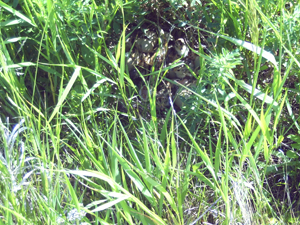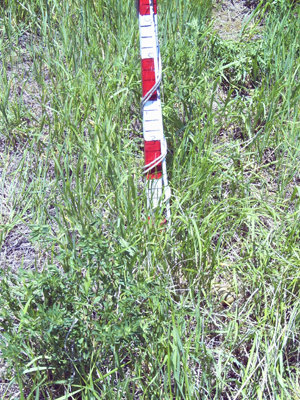G2155
Importance of Structure for Game Bird Production
Structure — the variety, height, and density of plant species available — is important for attracting nesting ring-necked pheasants and waterfowl. Landowners can improve structure through grazing and crop production management.
Karla H. Jenkins, Extension Beef and Range Management Specialist, University of Nebraska–Lincoln
Benjamin Geaumont, Research Assistant Professor, Wildlife and Range Science, North Dakota State University, Hettinger Research and Extension Center
|
Private landowners are aware that grazing management and the degree of rangeland utilization impacts resource sustainability for generations to come. Recently, farmers and ranchers have shown increased interest in management to maintain upland game bird and waterfowl populations for aesthetic, recreational, and economic reasons.
While food and water availability are always important to the survival of pheasants, structure is also important to whether pheasants choose to remain in an area for nesting and whether chick survival rates are acceptable. Maintaining structure on uplands in close proximity to water resources may be crucial if waterfowl production is a concern.
The definition of structure can include the species composition of the available plant community, but often it refers to the height and density of vegetation within a given habitat type. Height and density are critically important because they provide visual obstruction of the nest, hen, and chicks to predators (Figure 1).
Research studying the nesting habits of ring-necked pheasants and several upland nesting waterfowl species indicated the visual obstruction around nesting sites of pheasants averaged 9.5 inches, while that of waterfowl averaged 9.9 inches (Figure 2). Recent research suggests this level of visual obstruction does not need to be uniform throughout the entire area to maintain some game bird/waterfowl production. If a patchwork pattern of the acceptable level of visual obstruction exists, game birds will search out and select nesting sites within patches of acceptable cover.
Grazing management plans can impact upland game-bird nest site selection and survival. Overgrazing, regardless of the grazing system employed, can reduce new growth and residual herbage (structure) to levels unsuitable for nesting game birds and waterfowl. While research regarding the impact of livestock grazing on pheasant production is limited, recent research suggests that continuous season-long grazing targeting 50 percent utilization of vegetation has the potential to foster pheasant production, although it may be at rates below those found in idle grasslands. Research results regarding waterfowl production on pasture lands have been mixed; however, studies have reported the importance of maintaining residual cover for nesting waterfowl following the completion of any livestock grazing. While results indicated waterfowl production continued following the season-long grazing regime, it was at a reduced rate compared to that which occurred in idle grasslands.
Research regarding grazing systems effects on pheasant production is limited and livestock producers have their preferred grazing system which fits well with their management goals. As such, it may be possible to speculate how various systems may influence vegetation and, in return, influence the availability of structure for nesting. Short-term high density stocking rate rotational grazing or high stocking rate continuous grazing systems likely remove enough new growth and residual litter to negatively impact game bird nesting. Moderate stocking rate grazing plans that include rest or deferred rotational grazing, or continuous season-long grazing may be expected to provide better habitat for nesting.
Rest rotation plans have one pasture in the rotation that remains ungrazed for the growing season. Deferred grazing plans utilize every pasture in the rotation but move quickly through the pasture grazed early in the spring. In both rest rotation and deferred rotation plans, grazing begins in a different pasture each spring. This prevents utilization of the same species of forbs and grasses at the same time each year, which can be detrimental to plant vigor and ultimately wildlife habitat. Continuous season-long grazing plans can provide acceptable structure for game birds provided the stocking rate is low to moderate. Continuous season-long grazing allows cattle to graze very selectively, leaving less desirable plants to grow and provide potential structure for game-bird nesting. For more information on grazing plans, see Extension Circular, Integrating Management Objectives and Grazing Strategies on Semiarid Rangeland (EC158).
As previously discussed, properly managed pastures and idle permanent cover will provide adequate structure for nesting by game birds and upland nesting waterfowl. However, the expanding human population, increased crop prices, and the development of corn-based ethanol will likely increase the conversion of permanent cover to cropland, and utilization of cropland by game birds and waterfowl should be considered.
Ring-necked pheasant and some species of waterfowl, such as mallards and northern pintails, begin their first nest attempts in early spring, prior to new forage growth. This stresses the importance of residual cover for structure within a cropping system. Generally, spring-planted crops do not provide adequate structure to facilitate nesting attempts by upland game birds and waterfowl that may begin nesting as early as mid-April. In some areas of the Midwest, fall seeded winter wheat has demonstrated potential to provide adequate structure for nesting in early spring.
Annually, the first nest initiated by individual ring-necked pheasant and waterfowl hens often has the largest number of eggs or clutch size when compared to second and third nesting attempts. Thus, it is important to provide secure nesting cover during early spring to try to maximize production. Should the first nesting attempt be destroyed or abandoned, hens will often re-nest. However, subsequent nesting attempts often result in the hen laying fewer eggs than she did during her first nest attempt. Even though spring-planted crops may eventually reach appropriate height and density to provide attractive structure for hens attempting second or third nests, research suggests nesting hens generally do not initiate nesting within these crop fields.
Recent research compared idle lands, season-long grazing, hay fields, no-till barley, and no-till corn fields on post-Conservation Reserve Program (CRP) land for its ability to produce both wildlife and agricultural outputs. Within two years of converting the CRP lands to crop production, virtually all ring-necked pheasant and waterfowl production was lost, while those CRP lands converted to hay and grazing lands maintained some wildlife production. The ability of the hay land to promote nesting by ring-necked pheasant and waterfowl partially depended on the structure provided by regrowth following the single cutting of hay in early July during the previous year. No-till barley fields generally obtained structure values used by nesting ring-necked pheasant during mid-May, but still seemed unattractive to nesting hens. While crop lands within the study appeared to be relatively unimportant with respect to initial chick production of ring-necked pheasant, they likely provided secure brood rearing cover for some hens, as well as a potential food source.
Summary
While structure plays a role in where ring-necked pheasant and waterfowl choose to nest, there are likely numerous other factors that also drive nest site selection. However, unlike other factors, structure is one variable that landowners can actively manage with little effort, and many may already be doing so as part of their grazing plans. Landowners concerned with both wildlife and agriculture need to be aware that while commodity prices are high and demand is up, the conversion of permanent cover to cropland likely will result in lower production rates of both ring-necked pheasant and waterfowl. Furthermore, it is likely impossible to maximize both wildlife and agricultural outputs simultaneously, but tradeoffs between the two can result in suitable levels of both. Depending on the overall goals of the landowner and species of concern, management plans and targeted residual cover should shift accordingly.
This publication has been peer reviewed.
Visit the University of Nebraska–Lincoln Extension Publications website for more publications.
Index: Range & Forage
Pasture Management
Issued June 2012

